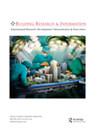低碳建筑交付中建筑信息建模和预制施工一体化的系统评价
IF 3.7
3区 工程技术
Q1 CONSTRUCTION & BUILDING TECHNOLOGY
引用次数: 3
摘要
摘要减少建筑和建筑物的排放是缓解气候变化的关键。因此,通过应用预制和建筑信息建模(BIM),向低碳排放行业转型是许多国家的重点。尽管预制和BIM有助于减少排放,但新兴的知识体系大多认为它们是分开的,往往忽视了它们在低碳建筑交付方面的协同作用。更重要的是,对BIM和预制一体化的现状仍缺乏全面的回顾。因此,本研究使用系统综述来探索BIM和预制的整合,以实现建筑交付中的低碳努力。揭示了为低碳活动整合BIM和预制的六种类型。因此,能源和环境评估;可视化和实时监控;参数化设计优化;建模自动化;BIM-PC修改;以及信息映射。此外,这些类型探讨了建筑交付中的四个主要低碳属性;能源评估、材料选择、废物减少和工艺效率。根据研究结果,确定了研究差距,并提供了未来的研究方向,如基于BIM的碳足迹分析工程量清单和预制构件的圆形特征。这项研究巩固了BIM和预制学术的进步,并为建筑低碳工艺的评估实践提供了信息。本文章由计算机程序翻译,如有差异,请以英文原文为准。
Systematic review on the integration of building information modelling and prefabrication construction for low-carbon building delivery
ABSTRACT Reducing emissions from construction and buildings is pivotal to climate change mitigation. Hence, transitioning to a low-carbon emission industry is the focus of many countries by applying prefabrication and building information modelling (BIM). Although prefabrication and BIM contribute towards reducing emissions, the burgeoning body of knowledge mostly consider them separate and often neglect advances in their synergies towards low-carbon building delivery. More importantly, a thorough review of the current state of BIM and prefabrication integration is still lacking. Therefore, this study uses the systematic review to explore the integration of BIM and prefabrication towards low-carbon efforts in building delivery. Six typologies of integrating BIM and prefabrication for low-carbon activities were revealed. Thus, energy and environmental assessments; visualization and real-time monitoring; parametric design optimization; automation in modelling; BIM-PC modifications; and information mapping. Further, these typologies explored four main low-carbon attributes in building delivery; energy evaluation, material selection, waste reduction and process efficiency. From the findings, research gaps were identified and future research directions such as BIM-based bill of quantities for carbon footprint analysis, and circularity features of prefabricated components were provided. This study consolidates advances in BIM and prefabrication scholarship and informs practice for evaluation of low-carbon processes in buildings.
求助全文
通过发布文献求助,成功后即可免费获取论文全文。
去求助
来源期刊

Building Research and Information
工程技术-结构与建筑技术
CiteScore
8.60
自引率
7.70%
发文量
43
审稿时长
>12 weeks
期刊介绍:
BUILDING RESEARCH & INFORMATION (BRI) is a leading international refereed journal focussed on buildings and their supporting systems. Unique to BRI is a focus on a holistic, transdisciplinary approach to buildings and the complexity of issues involving the built environment with other systems over the course of their life: planning, briefing, design, construction, occupation and use, property exchange and evaluation, maintenance, alteration and end of life. Published articles provide conceptual and evidence-based approaches which reflect the complexity and linkages between cultural, environmental, economic, social, organisational, quality of life, health, well-being, design and engineering of the built environment.
 求助内容:
求助内容: 应助结果提醒方式:
应助结果提醒方式:


